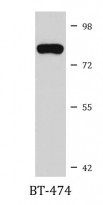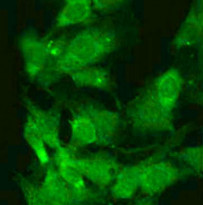anti-DDX3 antibody
CAT.NO. : ARG41738
US$ Please choose
US$ Please choose
Size:
Trail, Bulk size or Custom requests Please contact us
概述
| 产品描述 | Rabbit Polyclonal antibody recognizes DDX3 |
|---|---|
| 反应物种 | Hu, Ms, Rat |
| 应用 | ICC/IF, IHC-P, IP, WB |
| 宿主 | Rabbit |
| 克隆 | Polyclonal |
| 同位型 | IgG |
| 靶点名称 | DDX3 |
| 抗原物种 | Human |
| 抗原 | Recombinant fusion protein corresponding to aa. 1-220 of Human DDX3 (NP_001347.3). |
| 偶联标记 | Un-conjugated |
| 別名 | DDX14; DEAD box protein 3, X-chromosomal; CAP-Rf; Helicase-like protein 2; DEAD box, X isoform; DBX; HLP2; EC 3.6.4.13; DDX3; ATP-dependent RNA helicase DDX3X |
应用说明
| 应用建议 |
| ||||||||||
|---|---|---|---|---|---|---|---|---|---|---|---|
| 应用说明 | * The dilutions indicate recommended starting dilutions and the optimal dilutions or concentrations should be determined by the scientist. | ||||||||||
| 阳性对照 | BT-474 | ||||||||||
| 实际分子量 | ~ 80 kDa |
属性
| 形式 | Liquid |
|---|---|
| 纯化 | Affinity purified. |
| 缓冲液 | PBS (pH 7.3), 0.02% Sodium azide and 50% Glycerol. |
| 抗菌剂 | 0.02% Sodium azide |
| 稳定剂 | 50% Glycerol |
| 存放说明 | For continuous use, store undiluted antibody at 2-8°C for up to a week. For long-term storage, aliquot and store at -20°C. Storage in frost free freezers is not recommended. Avoid repeated freeze/thaw cycles. Suggest spin the vial prior to opening. The antibody solution should be gently mixed before use. |
| 注意事项 | For laboratory research only, not for drug, diagnostic or other use. |
生物信息
| 数据库连接 | |
|---|---|
| 基因名称 | DDX3X |
| 全名 | DEAD (Asp-Glu-Ala-Asp) box helicase 3, X-linked |
| 背景介绍 | The protein encoded by this gene is a member of the large DEAD-box protein family, that is defined by the presence of the conserved Asp-Glu-Ala-Asp (DEAD) motif, and has ATP-dependent RNA helicase activity. This protein has been reported to display a high level of RNA-independent ATPase activity, and unlike most DEAD-box helicases, the ATPase activity is thought to be stimulated by both RNA and DNA. This protein has multiple conserved domains and is thought to play roles in both the nucleus and cytoplasm. Nuclear roles include transcriptional regulation, mRNP assembly, pre-mRNA splicing, and mRNA export. In the cytoplasm, this protein is thought to be involved in translation, cellular signaling, and viral replication. Misregulation of this gene has been implicated in tumorigenesis. This gene has a paralog located in the nonrecombining region of the Y chromosome. Pseudogenes sharing similarity to both this gene and the DDX3Y paralog are found on chromosome 4 and the X chromosome. Alternative splicing results in multiple transcript variants. [provided by RefSeq, Oct 2014] |
| 生物功能 | Multifunctional ATP-dependent RNA helicase. The ATPase activity can be stimulated by various ribo- and deoxynucleic acids indicative for a relaxed substrate specificity. In vitro can unwind partially double-stranded DNA with a preference for 5'-single-stranded DNA overhangs. Is involved in several steps of gene expression, such as transcription, mRNA maturation, mRNA export and translation. However, the exact mechanisms are not known and some functions may be specific for a subset of mRNAs. Involved in transcriptional regulation. Can enhance transcription from the CDKN1A/WAF1 promoter in a SP1-dependent manner. Found associated with the E-cadherin promoter and can down-regulate transcription from the promoter. Involved in regulation of translation initiation. Proposed to be involved in positive regulation of translation such as of cyclin E1/CCNE1 mRNA and specifically of mRNAs containing complex secondary structures in their 5'UTRs; these functions seem to require RNA helicase activity. Specifically promotes translation of a subset of viral and cellular mRNAs carrying a 5'proximal stem-loop structure in their 5'UTRs and cooperates with the eIF4F complex. Proposed to act prior to 43S ribosomal scanning and to locally destabilize these RNA structures to allow recognition of the mRNA cap or loading onto the 40S subunit. After association with 40S ribosomal subunits seems to be involved in the functional assembly of 80S ribosomes; the function seems to cover translation of mRNAs with structured and non-structured 5'UTRs and is independent of RNA helicase activity. Also proposed to inhibit cap-dependent translation by competetive interaction with EIF4E which can block the EIF4E:EIF4G complex formation. Proposed to be involved in stress response and stress granule assembly; the function is independent of RNA helicase activity and seems to involve association with EIF4E. May be involved in nuclear export of specific mRNAs but not in bulk mRNA export via interactions with XPO1 and NXF1. Also associates with polyadenylated mRNAs independently of NXF1. Associates with spliced mRNAs in an exon junction complex (EJC)-dependent manner and seems not to be directly involved in splicing. May be involved in nuclear mRNA export by association with DDX5 and regulating its nuclear location. Involved in innate immune signaling promoting the production of type I interferon (IFN-alpha and IFN-beta); proposed to act as viral RNA sensor, signaling intermediate and transcriptional coactivator. Involved in TBK1 and IKBKE-dependent IRF3 activation leading to IFNB induction, plays a role of scaffolding adapter that links IKBKE and IRF3 and coordinates their activation. Also found associated with IFNB promoters; the function is independent of IRF3. Can bind to viral RNAs and via association with MAVS/IPS1 and DDX58/RIG-I is thought to induce signaling in early stages of infection. Involved in regulation of apoptosis. May be required for activation of the intrinsic but inhibit activation of the extrinsic apoptotic pathway. Acts as an antiapoptotic protein through association with GSK3A/B and BIRC2 in an apoptosis antagonizing signaling complex; activation of death receptors promotes caspase-dependent cleavage of BIRC2 and DDX3X and relieves the inhibition. May be involved in mitotic chromosome segregation. Appears to be a prime target for viral manipulations. Hepatitis B virus (HBV) polymerase and possibly vaccinia virus (VACV) protein K7 inhibit IFNB induction probably by dissociating DDX3X from TBK1 or IKBKE. Is involved in hepatitis C virus (HCV) replication; the function may involve the association with HCV core protein. HCV core protein inhibits the IPS1-dependent function in viral RNA sensing and may switch the function from a INFB inducing to a HCV replication mode. Involved in HIV-1 replication. Acts as a cofactor for XPO1-mediated nuclear export of incompletely spliced HIV-1 Rev RNAs. [UniProt] |
| 细胞定位 | Nucleus speckle. Cytoplasm. Mitochondrion outer membrane. Note=Located predominantly in nuclear speckles and, at low levels, throughout the cytoplasm. Located to the outer side of nuclear pore complexes (NPC). Shuttles between the nucleus and the cytoplasm in a XPO1 and may be also in a NFX1-dependent manner. Associated with polyadenylated mRNAs in the cytoplasm and the nucleus. Predominantly located in nucleus during G(0) phase and in the cytoplasm during G1/S phase. [UniProt] |
| 预测分子量 | 73 kDa |
| 翻译后修饰 | Phosphorylated by TBK1; the phosphorylation is required to synergize with TBK1 in IFNB induction. Phosphorylated by IKBKE at Ser-102 after ssRNA viral infection; enhances the induction of INFB promoter by IRF3. The cytoplasmic form is highly phosphorylated in the G1/S phase and much lower phosphorylated in G2/M. [UniProt] |
检测图片 (3)
ARG41738 anti-DDX3 antibody ICC/IF image
Immunofluorescence: C6 cells stained with ARG41738 anti-DDX3 antibody at 1:100 dilution.
ARG41738 anti-DDX3 antibody IHC-P image
Immunohistochemistry: Paraffin-embedded Human breast cancer tissue stained with ARG41738 anti-DDX3 antibody at 1:100 dilution.
ARG41738 anti-DDX3 antibody WB image
Western blot: 25 µg of BT-474 cell lysate stained with ARG41738 anti-DDX3 antibody at 1:1000 dilution.
 New Products
New Products

























